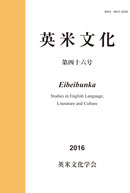Volume 29
Displaying 1-18 of 18 articles from this issue
- |<
- <
- 1
- >
- >|
-
Article type: Cover
1999 Volume 29 Pages Cover1-
Published: March 31, 1999
Released on J-STAGE: June 20, 2017
Download PDF (96K) -
Article type: Appendix
1999 Volume 29 Pages App1-
Published: March 31, 1999
Released on J-STAGE: June 20, 2017
Download PDF (4K) -
Article type: Index
1999 Volume 29 Pages Toc1-
Published: March 31, 1999
Released on J-STAGE: June 20, 2017
Download PDF (33K) -
Article type: Article
1999 Volume 29 Pages 5-26
Published: March 31, 1999
Released on J-STAGE: June 20, 2017
Download PDF (1665K) -
Article type: Article
1999 Volume 29 Pages 27-45
Published: March 31, 1999
Released on J-STAGE: June 20, 2017
Download PDF (1183K) -
Article type: Article
1999 Volume 29 Pages 47-58
Published: March 31, 1999
Released on J-STAGE: June 20, 2017
Download PDF (857K) -
Article type: Article
1999 Volume 29 Pages 59-72
Published: March 31, 1999
Released on J-STAGE: June 20, 2017
Download PDF (920K) -
Article type: Article
1999 Volume 29 Pages 73-87
Published: March 31, 1999
Released on J-STAGE: June 20, 2017
Download PDF (1301K) -
Article type: Article
1999 Volume 29 Pages 89-103
Published: March 31, 1999
Released on J-STAGE: June 20, 2017
Download PDF (1176K) -
Article type: Article
1999 Volume 29 Pages 105-114
Published: March 31, 1999
Released on J-STAGE: June 20, 2017
Download PDF (867K) -
Article type: Article
1999 Volume 29 Pages 115-128
Published: March 31, 1999
Released on J-STAGE: June 20, 2017
Download PDF (893K) -
Article type: Article
1999 Volume 29 Pages 129-139
Published: March 31, 1999
Released on J-STAGE: June 20, 2017
Download PDF (863K) -
Article type: Article
1999 Volume 29 Pages 141-150
Published: March 31, 1999
Released on J-STAGE: June 20, 2017
Download PDF (622K) -
Article type: Article
1999 Volume 29 Pages 151-173
Published: March 31, 1999
Released on J-STAGE: June 20, 2017
Download PDF (1366K) -
Article type: Article
1999 Volume 29 Pages 175-188
Published: March 31, 1999
Released on J-STAGE: June 20, 2017
Download PDF (803K) -
Article type: Appendix
1999 Volume 29 Pages 189-
Published: March 31, 1999
Released on J-STAGE: June 20, 2017
Download PDF (111K) -
Article type: Cover
1999 Volume 29 Pages Cover2-
Published: March 31, 1999
Released on J-STAGE: June 20, 2017
Download PDF (75K) -
Article type: Cover
1999 Volume 29 Pages Cover3-
Published: March 31, 1999
Released on J-STAGE: June 20, 2017
Download PDF (75K)
- |<
- <
- 1
- >
- >|
